|
|
|
 |
| |
|
|
Nelson Inn - 40 South
Street - 1785 to 1960 |
|
|
|
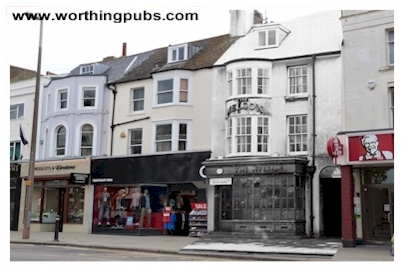 |
This is perhaps one of my
favourite pubs, because no one knows it was there. Shown left is a
superimposed picture of the Nelson Hotel in today's modern South
Street (at the time of writing), it may appear a little cramped, but
that's how things used to be. Retail premises these days seem to
require huge amounts of room, and so the ground floors were knocked
together, allowing the (then) Officers Club a double frontage.
The Nelson was originally the Admiral Nelson in 1802. It was
something I had long suspected: pubs rarely have single-word names,
and we tend to shorten them. The Cautious Fox, for example, would be
shortened to just 'the Fox' locally. |
| |
|
|
The Nelson, its large sign
protruding out into the street. Directly opposite was open grazing
land. On the extreme right was the Sea House Hotel, also displaying
its sign.
Worthing became a town in its
own right in 1803, and the Nelson was a meeting place for the new
town commissioners from 1803 to 1812. This was where modern Worthing
was planned. The desire, to become a holiday destination similar to
Brighton.
A newspaper from 1802
published coach running times and destinations. It was here that we
discovered it stopped at the then named Admiral Nelson Inn,
Worthing. |
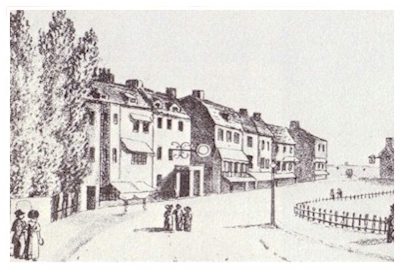 |
| |
|
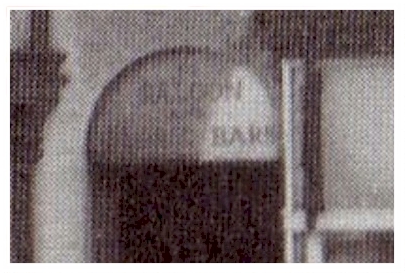 |
Looking at the first picture
in this set, you might have spotted the alleyway to the right of the
Nelson. Just above this is a painted sign shown on the left. The
text reads 'To Saloon and Public Bars'. The Nelson Inn at this time
had become a Hotel, providing a more respectable living for the
owner, a better class of clientele or simply, more money, but this
could mean losing regular local drinkers.
The solution would be to have the best of both worlds so the pub
moved to the rear. These adaptations were commonly known as 'Shades'
or 'Taps'. Another advantage was the ability to be able to serve
beer on a Sunday to travellers in a hotel. The official name for the
alleyway is Nelson's Passage. |
| |
|
| |
|
1960s |
| |
|
|
A report from the local paper:
It was wonderful, that last pint of bitter in the Nelson Hotel, in
Worthing's South-street, half a minute before it closed for good
last night.
Of course, I knew it was going to be a grand drink, even before the
first gush came from the pump nozzle. I had had one or two others
before that last one and they had been beer at its best.
Jack Knighton, the licensee, had done something about getting the
brew to an even lower temperature than usual - and it had always
been cool.
It was a sadly jolly evening: sad because we all knew that there
would be no tomorrow fir The Nelson, jolly because it always has
been at the Nelson. But although we all knew we were living the
pub's last few hours, little was said on the subject. We just drank
our beer and talked about the pools, the weather, the Birmingham
murder, pin-up girls, general things . . .Occasionally the talk
would stray on to some subject connected with pubs, and and the
gloom would move in again.
One or two hopeful rebels even spoke about raising a last-minute
petition, but we all knew that the eleventh hour had passed . . .
there would be no reprieve for the Nelson. |
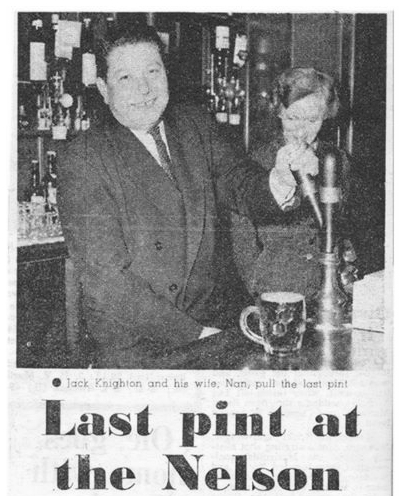 |
|
For more than 150 years, it
had dispensed English beer to the thirsty men and women. For more
than 150 years, it had watched life go by in Worthing's busy South
Street.It had been the meeting place of the ostlers of old and was
used as a coach stop in the days of the engineless carriage. But the
owners, Tamplins breweries, had decided the pub didn't pay, so this
was the death of the Nelson. P.L. (Taken from a local newspaper
article discovered by Alf Regis - exact date unknown.) |
| |
|
|
Searching for the
Shades |
|
|
|
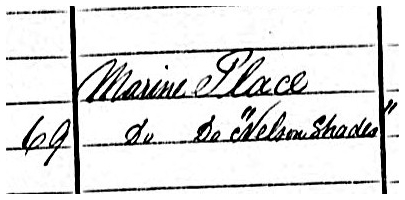 |
The first clue was this census
entry in 1871 which shows a 'Shades' in Marine Place at number 39,
directly behind the Nelson Hotel. (the number 69 is the entry
number, not the building number). The occupier was George Fillstone,
listed as bar manager.
There have since been other entries as 'Shades' or 'Taps', at the
same address. Now we have written evidence, we just need to pin it
down. |
|
|
|
|
Directly behind where the
Nelson Inn stood rests this building, demolished in 2023. We suspect
this was the Shades. The passageway on the extreme left is the other
end of Nelson's passage.
Although the South Street
frontage may have appeared narrow, the rear extents were much
bigger. Being a hotel/Inn there would have been a requirement for
stabling for guests' horses. As time passed, this diminished and
made an ideal extension for a shades bar. |
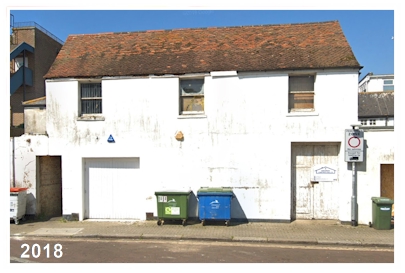 |
|
|
|
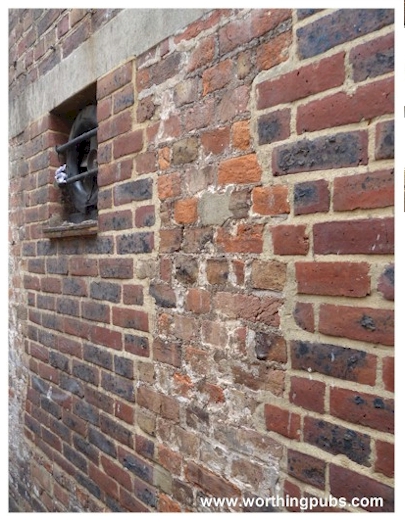 |
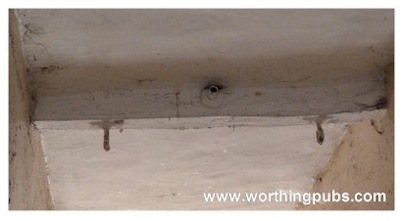
Down the passage on the Nelson side are three
bricked-up windows and a doorway. Left: Here you can see the
original bricks; very rough, hand-made multi-coloured bricks in high
contrast to the modern regular brick. The modern bricks mark where
the windows were.
In the covered part of the
passage ( shown above) on the ceiling, is a rather curious wooden
beam. It has two hooks and an old light bulb fitting. Was this
another 'sign' for the bar? |
| |
|
|
Searching for a hotel |
|
|
|
|
Henfrey Smail, in his
notations in 'Glimpses of Worthing' by Edward Snewin published in
1945, corrects Mr Snewin when he describes the Nelson Hotel as being
on the south side of Nelson Passage> Mr Smail clearly states that,
and I quote:
Mr Snewin places the Nelson Inn on the south side of the Nelson
passage, the premises now numbered 38, and formerly occupied by Mr
Farncombe the butcher, but there is no evidence that it ever stood
there and within living memory it has always occupied its present
site'.
The Nelson Inn is without question positioned at 40 South Street,
however, all is not as it seems A little investigation reveals that
Mr Swenin was right all along.
|
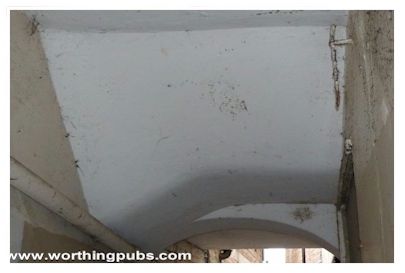 |
|
|
|
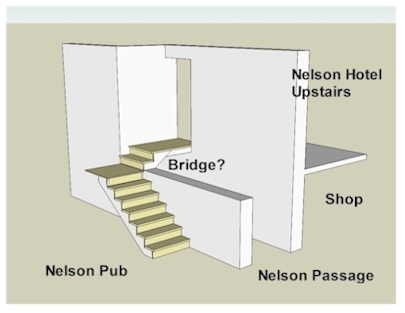 |
Taking a stroll up the
passage, we can see above our heads some unusual architecture. A
curious angle stretches across from one side to the other,
connecting number 40 to 38.
This, I believe to be a flight
of steps, with a small landing. In my mind a physical connection
between the two buildings. A set of stairs within the Nelson, ran up
the south wall, through it, over the passage to the upper floors of
the building next door. This would place the Nelson at number 40
South Street and the hotel at number 38.
Both sides were later bricked,
but I would bet that there is a sealed void in the structure shown
in the picture above. If it were ever opened up, I would imagine
we'd find a couple of steps inside.
|
| |
|
|
Time
Line |
A
little bit extra |
|
1783
1803 - Edmund Bland
1815 - For sale
1829 - George Newman
1836 - 1838 Edward Charles Irish (became bankrupt)
1840 - John Fowler
1849 - Thomas Henney (Nelson Hotel)
1842 - ceased being a Coaching Inn
1853 - Charles Stent - Nelson Commercial Inn
1858 - Richard Blair - Nelson inn
1859 - For sale
1861 - For sale
1869 - 1877 George Tillsone (Shades)
1894 - Ernest Ackerson Erredgw (Nelson Wine cabin)
1895 - Ben Read
1896 - W.J. Wilkinson
1901 Nelson shades - John Tullet
1901 - Nelson Hotel - William Ellsworth
1914 - W.H. Ellsworth
1931 - N Holden (Nelson Shades)
1937 - Internal rebuild
1953 - Georeg Smith
1960s Jack Knighton and wife Nan.
1961 - Closed

|
Clarissa Stent, daughter of
Charles Stent the landlord of the Nelson Hotel was to marry James
Greenyer the landlord of The Norfolk Arms.
Worthing Gazette 1959, an
article on the demise of the nelson mentions: 'The cellars are not
under the building now known as the Nelson, but under the adjoining
gown shop'.
|
| |
|
| |
|
 |
| |
|
| |
|